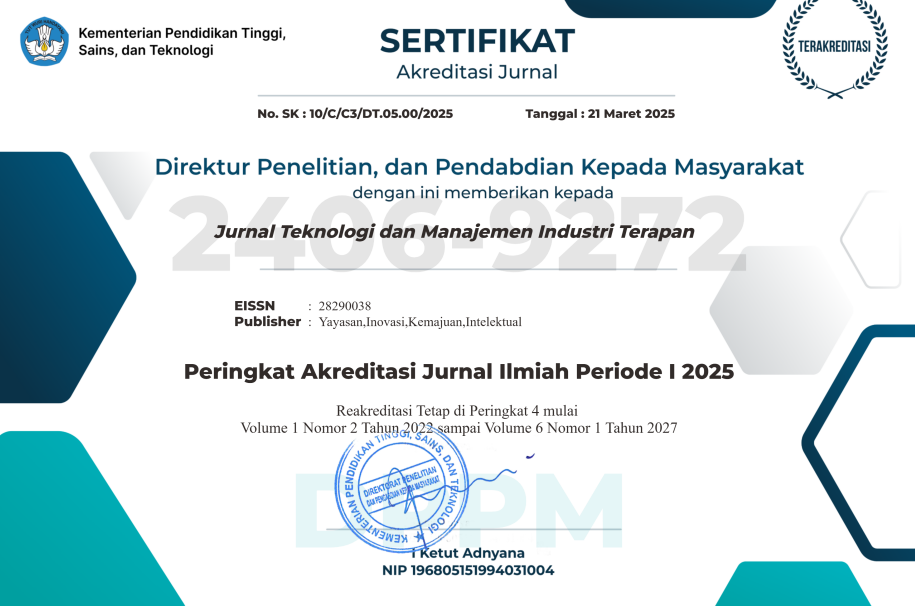Penerapan Failure Mode and Effect Analysis (FMEA) dan Fault Tree Analysis (FTA) pada Mesin Produksi untuk Peningkatan Keandalan
DOI:
https://doi.org/10.55826/jtmit.v4i4.1208Keywords:
FMEA, FTA, Product quality, RPNAbstract
PT. XYZ sebagai produsen beton masih menghadapi permasalahan kualitas produk berupa retak, segregasi, kuat tekan tidak sesuai, serta dimensi produk tidak presisi. Penelitian ini bertujuan menganalisis potensi kegagalan yang muncul pada proses produksi beton serta merancang langkah pengendalian menggunakan metode Failure Mode and Effect Analysis (FMEA) dan Fault Tree Analysis (FTA). Data terkait cacat produk dihimpun selama periode juli 2024 hingga januari 2025, kemudian dilakukan analisis untuk menghitung nilai Risk Priority Number (RPN). Dari hasil perhitungan, diketahui bahwa cacat dengan nilai RPN tertinggi adalah retak pada beton (RPN=288), diikuti segregasi (RPN=168), kuat tekan tidak sesuai (RPN=162), dan dimensi produk tidak presisi (RPN=48). Analisis lanjutan dengan FTA mengungkap bahwa akar penyebab berasal dari faktor manusia, lingkungan, dan mesin. Usulan perbaikan difokuskan pada peningkatan pelatihan operator, perawatan mesin secara berkala, standarisasi prosedur curing dan mixing, serta pengendalian kondisi lingkungan produksi. Temuan ini diharapkan dapat membantu perusahaan dalam meningkatkan kualitas produk beton dan mengurangi tingkat cacat produksi.
References
[1] A. R. Nurdifa, “Kontribusi Industri Pengolahan ke PDB Susut Jadi 18,67% Kuartal II/2025,” Bisnis.com, 2025, [Online]. Available: https://ekonomi.bisnis.com/read/20250805/257/1899423/kontribusi-industri-manufaktur-ke-pdb-susut-jadi-1867-kuartal-ii2025
[2] H. M. / AP3I, “AP3I: Produksi beton pracetak naik 10% tiap tahun,” Kontan.co.id, 2018, [Online]. Available: https://industri.kontan.co.id/news/ap3i-produksi-beton-pracetak-naik-10-tiap-tahun
[3] M. R. Ejaz, “Smart Manufacturing as a Management Strategy to Achieve Sustainable Competitiveness,” Journal of the Knowledge Economy, vol. 15, no. 1, pp. 682–705, 2024, doi: 10.1007/s13132-023-01097-z.
[4] M. Kastalani, M. Basjir, C. Yazirin, and N. Robbi, “Analysis Keandalan untuk Meningkatkan Efektivitas Penggunaan Forklift dengan Metode Reliability Analysis dan Machine’s Effectiveness,” Jurnal Rekayasa Teknologi, vol. 20, no. 1, pp. 1051–1062, 2024, [Online]. Available: https://journal.unusida.ac.id/index.php/jrt/article/view/1051
[5] R. Romo, F. Orozco, E. Forcael, and F. Moreno, “Towards a Model That Sees Human Resources as a Key Element for Competitiveness in Construction Management,” Buildings, vol. 13, no. 3, 2023, doi: 10.3390/buildings13030774.
[6] N. A. Saputra and H. C. Palit, “Upaya Peningkatan Skill dan Knowledge Operator untuk Handling Defects pada PT. X,” Jurnal Titra: Teknik Industri, vol. 9, no. 2, p. —, 2022, [Online]. Available: https://publication.petra.ac.id/index.php/teknik-industri/article/view/13008
[7] S. Di Luozzo, F. Starnoni, and M. M. Schiraldi, “On the relationship between human factor and overall equipment effectiveness (OEE): An analysis through the adoption of analytic hierarchy process and ISO 22400,” International Journal of Engineering Business Management, vol. 15, p. 18479790231188548, 2023, doi: 10.1177/18479790231188548.
[8] A. Maierhofer, S. Trojahn, and F. Ryll, “Dynamic Scheduling and Preventive Maintenance in Small-Batch Production: A Flexible Control Approach for Maximising Machine Reliability and Minimising Delays,” Applied Sciences, vol. 15, no. 8, 2025, doi: 10.3390/app15084287.
[9] A. Newman and C. Strack, “Supporting Production Consistency for Cement,” Sep. 2025, 150th anniversary of the Metre Convention and the BIPM with a poster on a metrology challenge. [Online]. Available: https://tsapps.nist.gov/publication/get_pdf.cfm?pub_id=959790
[10] “@article{Prastyabudi2022,”.
[11] “citations-20250923T150707”.
[12] S. Emir and N. Sulistyowati, “The effect of supply chain management and total quality management on operational performance through competitive advantage,” International Journal of Research in Business and Social Science (2147- 4478), vol. 13, no. 1, pp. 27–37, Feb. 2024, doi: 10.20525/ijrbs.v13i1.3087.
[13] S. Uthaman and V. Vishwakarma, “Assessment of causes and consequences of concrete deterioration and its remediation,” Journal of Building Engineering, vol. 79, p. 107790, 2023, doi: https://doi.org/10.1016/j.jobe.2023.107790.
[14] I. S. Firmansyah and Suparno, “Improvement of Overhaul Maintenance Management System Based on Failure Mode Operation Failure Analysis Using The FMEA Method,” in IPTEK Journal of Proceedings Series, Institut Teknologi Sepuluh Nopember (ITS), 2024. [Online]. Available: https://iptek.its.ac.id/index.php/jps/article/view/11224
[15] H. Hidayat, D. Andesta, and M. F. Baad, “Enhancing Quality Control in the Indonesian Automotive Parts Industry: A Defect Reduction Approach Through the Integration of FMEA and MSA,” Instrumentation Mesure Métrologie, vol. 23, no. 1, pp. 57–64, 2022, doi: 10.18280/i2m.230104.
[16] S. Lestari, D. Septiyana, and W. Yuniawati, “Analisis Metode Failure Mode and Effect Analysis (FMEA) dan Fault Tree Analysis (FTA) Untuk Identifikasi Penurunan Kualitas Produk Toyota Hi-Ace (Studi Kasus di PT. EDS Manufacturing Indonesia),” UNISTEK: Jurnal Sains dan Teknologi, vol. 8, no. 2, pp. 1456–1465, 2021, [Online]. Available: https://ejournal.unis.ac.id/index.php/UNISTEK/article/view/1456
[17] M. Mokhtarzadeh, J. Rodríguez-Echeverría, I. Semanjski, and S. Gautama, “Hybrid intelligence failure analysis for industry 4.0: a literature review and future prospective,” J Intell Manuf, vol. 36, no. 4, pp. 2309–2334, 2025, doi: 10.1007/s10845-024-02376-5.
[18] J. J. Cardiel-Ortega and R. Baeza-Serrato, “Failure Mode and Effect Analysis with a Fuzzy Logic Approach,” Systems, vol. 11, no. 7, 2023, doi: 10.3390/systems11070348.
[19] F. Ehiagwina, O. Kehinde, L. Afolabi, and I. S. Olatinwo, “Fault Tree Analysis and its Modifications as Tools for Reliability and Risk Analysis of Engineering Systems -An Overview,” vol. 3, pp. 383–396, Sep. 2022.
[20] M. D. Farrizqi and D. Andesta, “Quality Control Analysis Using the Failure Mode Method and Effect Analysis and Fault Tree Analysis on Songkok UD.XYZ Products,” G-Tech: Jurnal Teknologi Terapan, vol. 8, no. 2, pp. 835–846, Apr. 2024, doi: 10.33379/gtech.v8i2.4052.
[21] K.-H. Chang, T.-Y. Fang, and Z.-S. Li, “Using a Flexible Risk Priority Number Method to Reinforce Abilities of Imprecise Data Assessments of Risk Assessment Problems,” Electronics (Basel), vol. 14, no. 3, 2025, doi: 10.3390/electronics14030518.
[22] A. Setiawan and others, “Studi Kasus Analisis Defect Pada Komponen Otomotif Disertai Pemecahan Masalah Menggunakan Diagram Pareto dan Fishbone,” Jurnal Ilmiah Riset dan Sains, vol. 7, no. 2, pp. 4748–4756, 2023, [Online]. Available: https://ejurnal.kampusakademik.co.id/index.php/jirs/article/view/4748
[23] B. D. Rahmawati and N. N. B. Maharani, “Assessing Cause of Defect Using Failure Mode and Effect Analysis,” Spektrum Industri, vol. 21, no. 1, pp. 1–7, May 2023, doi: 10.12928/si.v21i1.91.
[24] M. N. B. Simbolon, P. D. Saputra, and M. Ragil, “Risk Priority Number Measurement for Construction Safety Risks in Upper Structure Projects of Military Airbase Hangars Based on Activity,” Engineering Proceedings, vol. 84, no. 1, 2025, doi: 10.3390/engproc2025084036.
[25] K. Pan et al., “Towards a Systematic Description of Fault Tree Analysis Studies Using Informetric Mapping,” Sustainability, vol. 14, no. 18, 2022, doi: 10.3390/su141811430.
Downloads
Published
Issue
Section
License
Copyright (c) 2025 Bilqis Nada Nabila, Said Salim Dahda, Efta Dhartikasari Priyana

This work is licensed under a Creative Commons Attribution-NonCommercial-ShareAlike 4.0 International License.


















